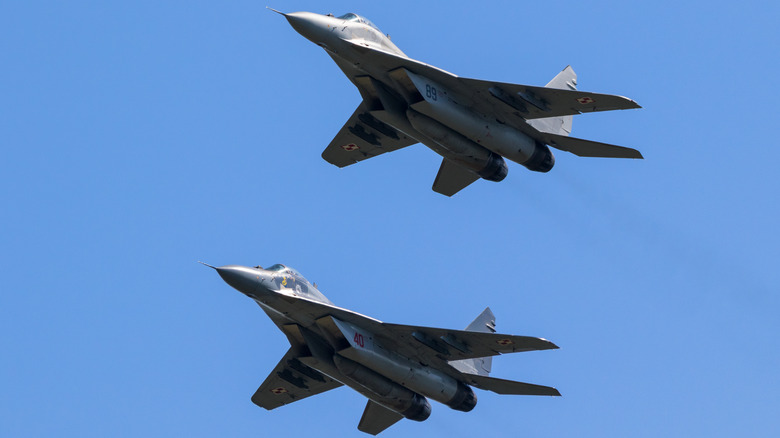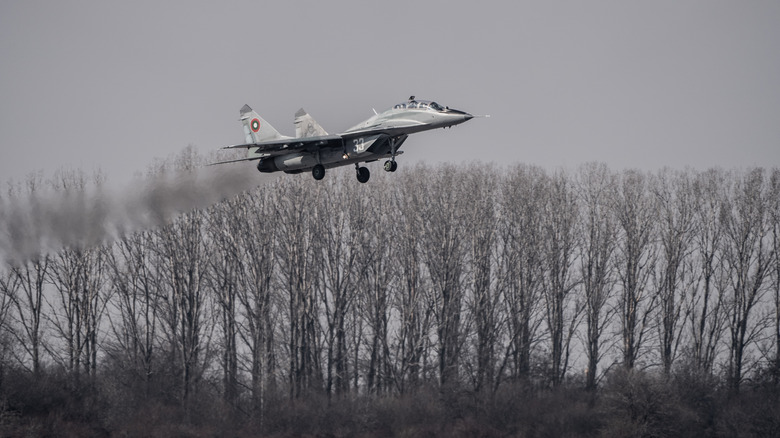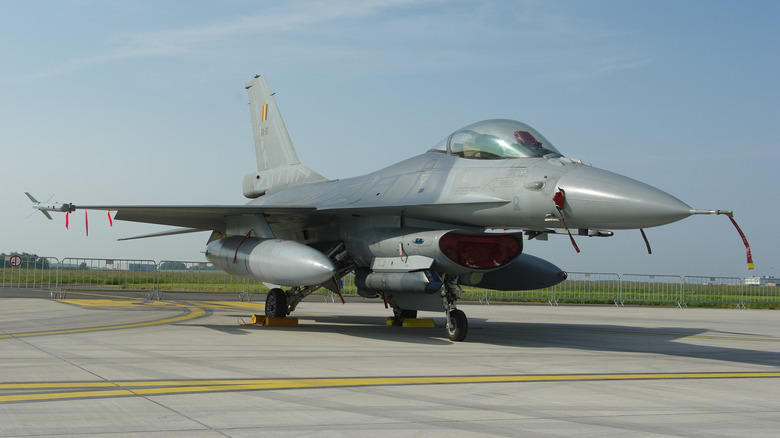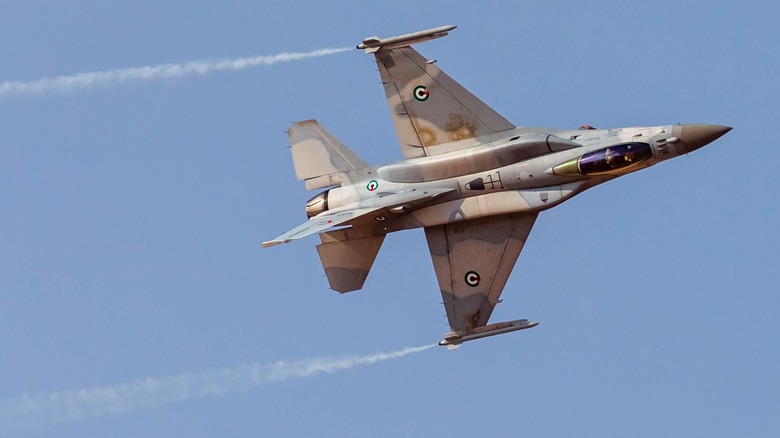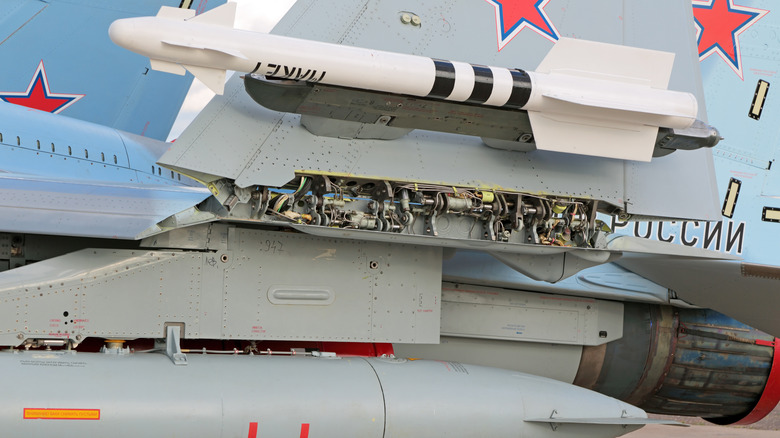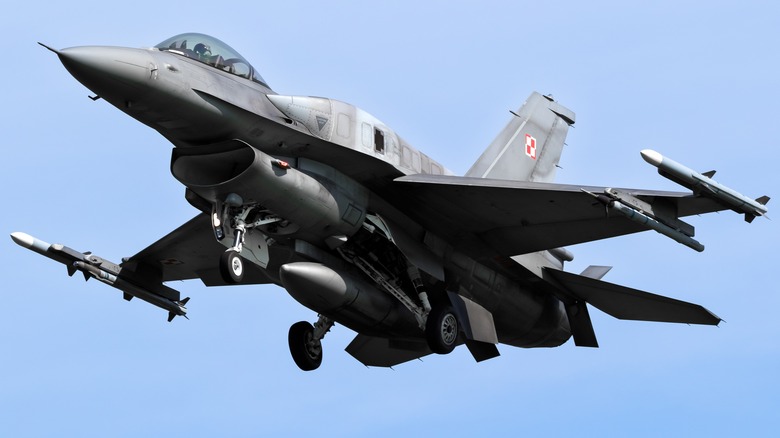MiG-29 Vs F-16: How The Two Fighter Jets Compare
The armed forces of both the Soviet Union and the United States made massive efforts to evolve and modernize throughout the Cold War as both sides looked to maintain air superiority. In fact, so many resources went into these efforts that some of the best fighter jets were developed during the Cold War. Two results of this aerodynamic arms race were the MiG-29 and the F-16 — both fighter jets were developed around the same time but nonetheless had many key differences.
The Mikoyan MiG-29 succeeded the MiG-17 and other early fighter jets after being developed by the Soviet Union in the 1970s. It was originally designed for air-to-air combat, with agility and maneuverability at its core, though it was later altered and upgraded for a broader range of missions. The F-16, on the other hand, was engineered from the ground up to be a multi-role fighter for the U.S. Air Force. The design of the F-16, one of the greatest fighter jets of all time, incorporated lessons learned from the Vietnam War and resulted from a desire for lightweight and efficient fighters.
There are similarities and differences between the MiG-29 and F-16 in all aspects, including design, performance, weapons systems, mission parameters, and the history of the aircraft. Here is how the two fighter jets compare.
The Soviet Union designed the MiG-29, but wasn't the only nation to fly it
As a result of the Soviet Union looking to add advanced lightweight fighters to its air force, the Mikoyan MiG-29 was developed in the early 1970s. After its first official test flight was conducted on October 6, 1977, the Soviets were eager to deploy the new fighter jet. When the first mission-ready aircraft rolled off the assembly line in 1982, the MiG-29 was still undergoing flight tests.
While technical improvements and upgrades have been incorporated into the MiG-29 over the past few decades, it's proven itself to have a reliable design and is still in service today. After manufacturing planes for its own armed forces in the 1980s, the Soviet Union began exporting the MiG-29 to its allies as well, including Poland and Belarus. However, these exported MiGs were purposely designed without some advanced features, including the ability to use nuclear weapons.
Over 30 nations have deployed the MiG-29 as part of their armed forces, and the jet is still in service for many countries, including India, Ukraine, Germany, Peru, Iran, North Korea, and, of course, Russia. Out of the approximately 1,600 MiG-29s currently operational around the world, around 600 are in service with the Russian Air Force.
The F-16 was born out of the Cold War and is currently deployed in Ukraine
The F-16 Fighting Falcon was developed by General Dynamics, which is now Lockheed Martin. It came about when the U.S. looked to add a fleet of relatively cheap and easy-to-produce fighter jets that could defend against and eliminate other enemy aircraft, though its mission parameters soon expanded to a wider range of uses. The original F-16 cost only $14.6 million to make, living up to the Air Force's goal of an inexpensive jet that could be mass-produced. Its maiden flight — conducted from Edwards Air Force Base on February 2, 1974 — lasted 90 minutes. Three days later, the F-16 had its first supersonic flight.
By the time the F-16A began full production in late 1976, several changes had been made to its design to better suit the needs of the U.S. military, including an increased wing area and larger nose radome for more advanced radar. Several U.S. allies immediately expressed interest in adding the F-16 to their arsenals as well, and the jet was quickly put into service by nations including Norway, Belgium, Denmark, and the Netherlands.
By 2010, over 4,500 F-16s had been delivered by Lockheed Martin to the U.S. and other countries, with over two dozen nations still currently using the jet, including Egypt, Greece, Indonesia, Taiwan, Israel, South Korea, Poland, and the United States. Since being invaded by Russia in 2022, Ukraine has also added several F-16s to its air force.
The F-16 is smaller than the MiG-29 but it can't fly as high
Both the MiG-29 and F-16 have seen many improvements and alterations since their maiden flights several decades ago, and there are variants of both fighters deployed around the world. With a crew of one, the MiG-29 has a wingspan of 37 feet 3 inches and is 57 feet long. When empty, the plane weighs 24,250 pounds and has a fuel capacity of 7,716 pounds, providing it a normal range of 772 nautical miles and a maximum range of 1,300 nm.
Powered by two RD-33 turbofan engines, the MiG-29 can reach nearly 1,500 mph at altitude (its service ceiling is a little over 59,000 feet) and over 900 mph near the ground. While taxiing and moving on the ground, the air intakes to its engines are closed and rerouted, preventing debris from being sucked in, making it well-suited for runways and airfields in deserts and other hostile terrain that haven't been cleaned and properly prepared.
The F-16 can support a crew of one or two, depending on the model. The jet is shorter and has a smaller wingspan than the MiG-29 — it is 49 feet 5 inches long and 32 feet 8 inches wide. It's also a considerably lighter aircraft, weighing 19,700 pounds when empty. It has an internal fuel capacity of about 7,000 pounds and can support another 5,000 pounds, with two external tanks.
The original F-16 used a Pratt & Whitney F100 turbofan engine; many later F-16s would use a General Electric F110-GE-100/129. The Fighting Falcon can reach Mach 2 at altitude, has a range of over 2,000 miles, and has a service ceiling of 50,000 feet and above.
Both fighter jets are capable of nuclear strikes
During the height of the Cold War, the Soviets and Americans made sure their new fighter jets would pack plenty of punch — and they still do. The MiG-29 is geared towards short-range combat with other aircraft and is outfitted accordingly, hosting seven different external weapon hardpoints. When it comes to air-to-air missiles, the fighter jet can carry up to six R-73 and R-60 missiles and up to two R-27 missiles — the latter are medium-range weapons, while the R-73 and R-60 are short-range.
Four pods of unguided rockets (S-5, S-8, and S-24) and air bombs that can weigh up to 3,000 kilograms round out the MiG-29's arsenal, along with a built-in 30mm aircraft gun with 150 rounds. Not only are these weapons deadly, but they can be very accurate thanks to the aircraft's N-019 radar, laser rangefinder, infrared search and track sensor, and helmet-mounted target designator. Additionally, the R-27 missiles use radar guidance and can intercept targets at altitudes between 0.02–27 kilometers at speeds up to 3,500 kph.
The F-16 is designed for combat in all-weather situations and can be armed with up to six air-to-air missiles, including AIM-9 Sidewinders and AIM-120 AMRAAMs. Additionally, it can be provisioned with up to 500 rounds for its single M61A1 20 mm aircraft cannon. Both the MiG-29 and F-16 can be equipped with nuclear weapons. The MiG-19 has been armed with tactical nukes with blast yields of up to 30 kilotons. The F-16 can carry most air-to-surface weapons in the United States Air Force arsenal, including nuclear bombs.
The evolution of the MiG-29 and F-16
Shortly after the MiG-29 began full production, a two-seat variant was designed for training. The MiG-29UB had a tandem cockpit and first flew on April 29, 1981. The MiG-29 Tactical Fighter, which started production in 1986, was also known as the Hunchback or Fatback due to a raised fuselage spine that could store additional fuel and extend the range of the fighter. It was also equipped with an advanced (at the time) Electronic CounterMeasures (ECM) suite. Improvements to the MiG-29 have been incorporated throughout its lifespan, including upgraded radar and targeting systems, flight control advancements, and an increase in its maximum take-off weight that allows the MiG-29 to carry even more weaponry.
Like the MiG-29, two-seat F-16 variants have been built for training exercises. Also, like the former, the F-16 has seen upgrades to its radar, weapons, and targeting systems, allowing it to admirably perform in all weather conditions. Still widely used in service, the F-16 is still being tinkered with and upgraded even to this day. Eventually, both fighter jets will likely be made obsolete by successor aircraft. The MiG-41, for example, is set to become the fastest plane ever and could be capable of Mach 5.
The F-16 will likely be replaced by the F-35 at some point. Like its predecessor, the F-35 has been designed to be a versatile multirole fighter — it has substantial upgrades when it comes to speed, stealth, and weaponry that help make it stand out as a next-generation fighter jet. For now, though, the F-16 (and the MiG-29) aren't going anywhere and are still patrolling the skies over many nations and conflict zones.
